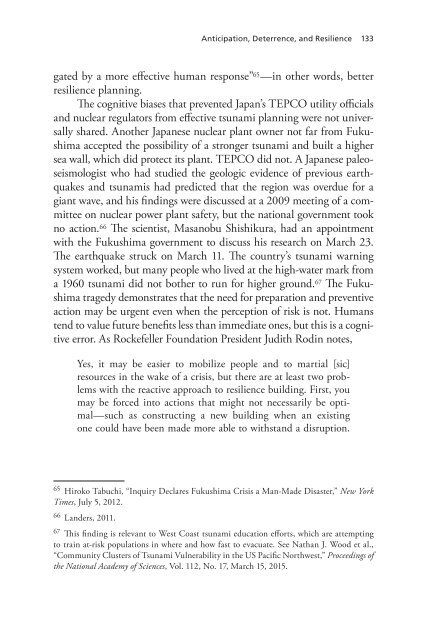You also want an ePaper? Increase the reach of your titles
YUMPU automatically turns print PDFs into web optimized ePapers that Google loves.
Anticipation, Deterrence, and Resilience 133<br />
gated by a more effective human response” 65 —in other words, better<br />
resilience planning.<br />
The cognitive biases that prevented Japan’s TEPCO utility officials<br />
and nuclear regulators from effective tsunami planning were not universally<br />
shared. Another Japanese nuclear plant owner not far from Fukushima<br />
accepted the possibility of a stronger tsunami and built a higher<br />
sea wall, which did protect its plant. TEPCO did not. A Japanese paleoseismologist<br />
who had studied the geologic evidence of previous earthquakes<br />
and tsunamis had predicted that the region was overdue for a<br />
giant wave, and his findings were discussed at a 2009 meeting of a committee<br />
on nuclear power plant safety, but the national government took<br />
no action. 66 The scientist, Masanobu Shishikura, had an appointment<br />
with the Fukushima government to discuss his research on March 23.<br />
The earthquake struck on March 11. The country’s tsunami warning<br />
system worked, but many people who lived at the high-water mark from<br />
a 1960 tsunami did not bother to run for higher ground. 67 The Fukushima<br />
tragedy demonstrates that the need for preparation and preventive<br />
action may be urgent even when the perception of risk is not. Humans<br />
tend to value future benefits less than immediate ones, but this is a cognitive<br />
error. As Rockefeller Foundation President Judith Rodin notes,<br />
Yes, it may be easier to mobilize people and to martial [sic]<br />
resources in the wake of a crisis, but there are at least two problems<br />
with the reactive approach to resilience building. First, you<br />
may be forced into actions that might not necessarily be optimal—such<br />
as constructing a new building when an existing<br />
one could have been made more able to withstand a disruption.<br />
65 Hiroko Tabuchi, “Inquiry Declares Fukushima Crisis a Man-Made Disaster,” New York<br />
Times, July 5, 2012.<br />
66 Landers, 2011.<br />
67 This finding is relevant to West Coast tsunami education efforts, which are attempting<br />
to train at-risk populations in where and how fast to evacuate. See Nathan J. Wood et al.,<br />
“Community Clusters of Tsunami Vulnerability in the US Pacific Northwest,” Proceedings of<br />
the National Academy of Sciences, Vol. 112, No. 17, March 15, 2015.




